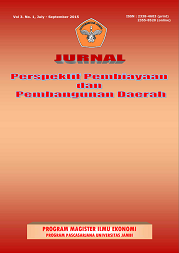Analisis Kebutuhan dan Kapasitas Fiskal serta Hubungannya dengan Belanja Pegawai di Kabupaten Tebo
DOI:
https://doi.org/10.22437/ppd.v3i1.2637Abstract
The ability of fiscal capacity that does not support the fiscal needs allows the fiscal gap . General Allocation Grand which comes from the central government aims to address the fiscal gap . Based on the explanation Regulation No. 55 of 2005 on the balance funds , General Allocation Grand (DAU) aimed at inter- regional equalization capabilities through the application of a formula that takes into account the needs of personnel expenditure , fiscal needs and potential of the region . This study was conducted to determine the effect of Construction Cost Index , Relative Poverty Index and Human Development Index for Fiscal Needs . This study uses multiple regression analysis 2001-2011 . And to determine the relationship of DBH and Local Revenue Fiscal Capacity in Tebo regency, as well as to determine the relationship between Fiscal Capacity, Fiscal Needs and personnel expenditures performed by Pearson correlation test . The survey results revealed that the Construction Cost Index and relative poverty index negatively affect on Fiscal Needs . Human Development Index positive effect on Fiscal Needs in Tebo. Pearson correlation of test results are known DBH positively and significantly associated with a P value or Sig 0,000 and Locally Generated Revenue positive and significant with a P value Fiscal Capacity sig 0.033 or less than 0.05 . Fiscal Needs and Fiscal Capacity positively associated with personnel expenditures and significant with a P value or Sig 0.000 or less than 0.05.Downloads
Downloads
Published
How to Cite
Issue
Section
License
Copyright (c) 2015 Sri Rosmawati, M. Rachmad. R, Zamzami Zamzami

This work is licensed under a Creative Commons Attribution 4.0 International License.

















